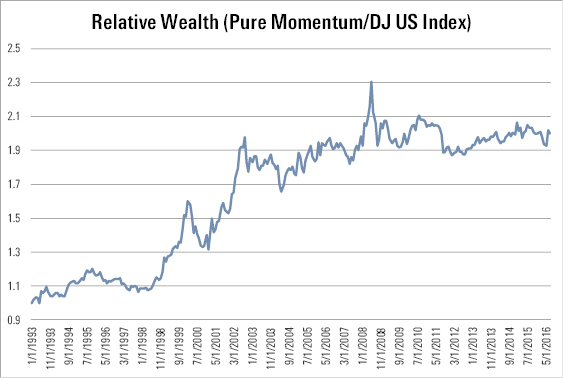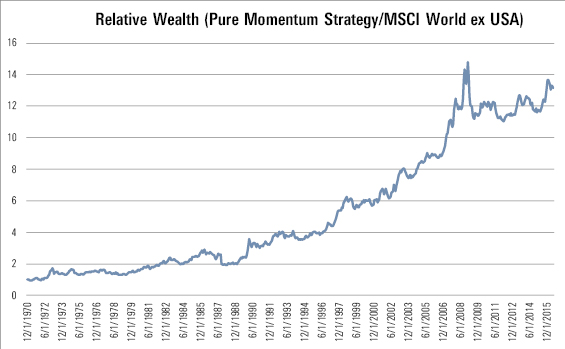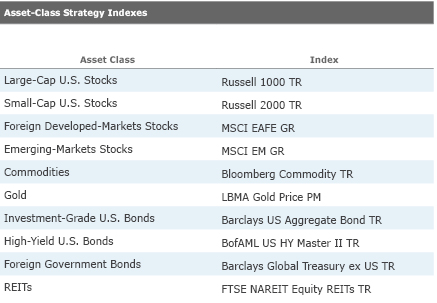Harnessing Momentum With Indexes
Momentum is so pervasive that it appears among both individual securities and entire indexes.
A version of this article was published in the September issue of Morningstar ETFInvestor newsletter. Download a complimentary copy of ETFInvestor by visiting the website.
Momentum, the tendency for recent performance to persist in the short term, is one of the most pervasive forces in financial markets. It is difficult to reconcile with the efficient-market hypothesis, which predicts that market prices reflect all publicly available information, including past performance. In fact, Eugene Fama and Ken French, two leading proponents of the efficient-market hypothesis, have called it the premier market anomaly.
There are three potential behavioral biases that could cause momentum: anchoring, disposition, and herding. The first two cause prices to initially adjust to new information more slowly than they should (underreaction), while the third leads to overreaction. Anchoring is based on the idea that investors ground their investment thesis in information they already know and are slow to update their view in response to new information. This phenomenon is consistent with post-earnings-announcement drift, a situation in which firms beat (or miss) earnings expectations, and their stocks pop (or drop) on the day they make that announcement, but continue to outperform (or underperform) during the subsequent several weeks.
The disposition effect describes many investors’ tendency to sell stocks whose prices have increased in order to lock in profits and hold on to stocks that have declined in value in the hope of breaking even, despite changing fundamentals. This behavior is related to loss aversion, where the pain of losing money exceeds the utility from an equal-sized gain. Like anchoring, this can cause prices to adjust more slowly than they should in the face of changing fundamentals, as investors exhibiting this behavior make their trading decisions based on the price that they paid for a security rather than its fundamental value.
Once a trend is established, investors may chase performance and pile into the trade, which could push prices away from fair value (herding behavior). This could lead to the long-term performance reversals associated with the value effect. These long-term reversals make long-term performance-chasing counterproductive.
Momentum is a short-term phenomenon, where relative performance during the past six to 12 months tends to persist over the next several months. Academic studies most commonly measure momentum based on performance during the past 12 months, excluding the most recent one (though the effect persists even without this exclusion), and rebalance monthly.
While investors should arbitrage any predictable pricing pattern away, momentum has persisted more than two decades after it was first widely documented in the academic literature. It is difficult to fully arbitrage because it requires high turnover, which can make the strategy difficult and costly to implement, and it doesn’t always pay off. Simple momentum strategies often don’t work well when volatility picks up, or during sharp market reversals, when performance leadership changes. Just like any other investment strategy, momentum carries its own risks.
Momentum strategies, like
Sector Strategy To assess whether it is possible to profit from sector-level momentum, I ran an analysis using the 10 Dow Jones U.S. sector indexes. I chose these particular indexes because they have the longest history of any set of equity sector benchmarks. IShares' U.S. equity sector ETFs track these indexes, but Vanguard and the Select Sector SPDR ETFs offer similar exposure with lower fees.
Each month, I ranked the indexes by their returns during the past 12 months and selected the three with the best returns. I initially equally weighted these holdings but did not rebalance them until they were removed from the portfolio. For instance, if two positions were sold, the proceeds would be divided equally between the two new holdings. However, the existing holding would remain in the portfolio at its current weighting. This approach reduces turnover and makes the strategy easier and less costly to implement. The portfolio simulation began in December 1992 (using index return data starting in December 1991, the earliest available) and ran through July 2016. This strategy is labeled pure momentum in Exhibit 1, which illustrates the results.

- source: Morningstar Analysts
The strategy outpaced the broad, market-cap-weighted Dow Jones U.S. Index and an equally weighted portfolio of the 10 sector indexes by 3.3 and 2.36 percentage points annualized, respectively, with slightly greater volatility. Much of this outperformance occurred between 1998 and June 2008, as Exhibit 2 shows. The strategy fared less well during the trailing five years through July 2016, during which time it lagged the index by 91 basis points annualized. This illustrates that, although the momentum strategy has tended to work well over the long term, it can experience long periods of underperformance.

- source: Morningstar Analysts
This strategy offers clean exposure to the momentum effect because it aggressively rebalances each month and quickly dumps holdings that are no longer among the strongest recent performers. But it also requires high turnover, which can erode returns in practice. On average, the strategy required 13.6 trades each year, for a turnover ratio of 242%.
However, it is possible to modify the strategy to reduce turnover. To accomplish this, I reconstituted the momentum portfolio quarterly, instead of monthly, and implemented a buffering rule. As long as the existing holdings’ performance ranked in the top four of the 10 indexes, I would not sell them because they would still have decent momentum. If there were fewer than three indexes that satisfied that condition, I would select the top-ranking indexes remaining until the portfolio had three.
These adjustments cut turnover by more than half, requiring an average of 5.2 trades per year, as the data in the Modified Strategy column in the table above show. And the strategy still outperformed the market-cap-weighted index by a considerable margin. It was somewhat surprising that the modified strategy did a little better than the original because it is less style-pure, though this result is probably not significant. The important point is that these modest adjustments should improve cost efficiency, making it easier to profit from momentum in practice.
Country Strategy Investors could apply a similar strategy using single-country index funds in their foreign-equity allocations. For this analysis, I included the MSCI country indexes for all members of the developed-markets MSCI World ex USA Index with a December 1969 inception date. This left 17 country indexes. Each month from December 1970 through July 2016, I ranked these indexes by their returns for the previous 12 months and selected the five with the best returns. The same weighting and rebalancing approach described for the sector strategy applies here. As before, I also ran a modified version of this strategy. This version refreshes quarterly and applies a buffer rule that favors existing holdings that rank in the top seven of the 17 indexes.

- source: Morningstar Analysts
The pure momentum strategy significantly outperformed the market-cap-weighted MSCI World ex USA Index and equal-weighted portfolio of the 17 country indexes. The consistency of its (back-tested) outperformance is surprising, though there have been rough patches, such as the first half of 2009. And it would have required 20.4 trades per year on average.

- source: Morningstar Analysts
The modified version of the strategy didn’t work quite as well, but it still posted a higher return than its benchmarks, albeit with greater volatility. And similar to the modified sector strategy, it required less than half of the original’s turnover.
Asset-Class Strategy Momentum is also alive and well at the asset-class level. But its ever-changing risk profile can make it difficult to implement. But because it is shifting across asset classes, the strategy's risk profile can change dramatically over time, which can make it difficult to put into practice. It is important to keep in mind that risk tolerance should be the primary determinant of asset allocation.
For the asset-class strategy, I included the 10 indexes listed in Exhibit 5.

- source: Morningstar Analysts
I followed the same procedure as described for the previous two strategies. But similar to the sector strategy, this strategy only held three indexes and the modified version favored existing holdings as long as their returns ranked in the top four of the 10 indexes. I ran the portfolio simulation from the end of 1992 (the earliest point at which a full year of data became available for all the indexes) through July 2016. To benchmark the performance of these strategies, I included both a blended 60/40 benchmark of the Dow Jones U.S. Total Stock Market Index and Barclays U.S. Aggregate Bond Index, and an equal-weighted portfolio of all 10 eligible indexes.

- source: Morningstar Analysts
Both versions of the momentum strategy beat the two benchmarks, with greater volatility. The pure momentum strategy had a particularly strong run between 2001 and February 2009, but it significantly underperformed during the next few months and between May 2011 and March 2012. The modified version posted a smaller return edge but considerably lower turnover.
Summary
- Momentum is a short-term phenomenon that has been observed in nearly every market studied. It likely arises from three behavioral biases: anchoring, disposition, and herding.
- Investors can take advantage of momentum with funds that apply the strategy to individual stocks, or apply it directly using ETFs offering exposure to equity sectors, single countries, or individual asset classes.
- Modest adjustments to a simple ETF momentum strategy can reduce transaction costs and make it easier to profit from momentum in practice.

Disclosure: Morningstar, Inc. licenses indexes to financial institutions as the tracking indexes for investable products, such as exchange-traded funds, sponsored by the financial institution. The license fee for such use is paid by the sponsoring financial institution based mainly on the total assets of the investable product. Please click here for a list of investable products that track or have tracked a Morningstar index. Neither Morningstar, Inc. nor its investment management division markets, sells, or makes any representations regarding the advisability of investing in any investable product that tracks a Morningstar index.

/s3.amazonaws.com/arc-authors/morningstar/56fe790f-bc99-4dfe-ac84-e187d7f817af.jpg)
/cloudfront-us-east-1.images.arcpublishing.com/morningstar/24UPFK5OBNANLM2B55TIWIK2S4.png)
/d10o6nnig0wrdw.cloudfront.net/04-25-2024/t_29c382728cbc4bf2aaef646d1589a188_name_file_960x540_1600_v4_.jpg)
/cloudfront-us-east-1.images.arcpublishing.com/morningstar/T2LGZCEHBZBJJPPKHO7Y4EEKSM.png)
:quality(80)/s3.amazonaws.com/arc-authors/morningstar/56fe790f-bc99-4dfe-ac84-e187d7f817af.jpg)